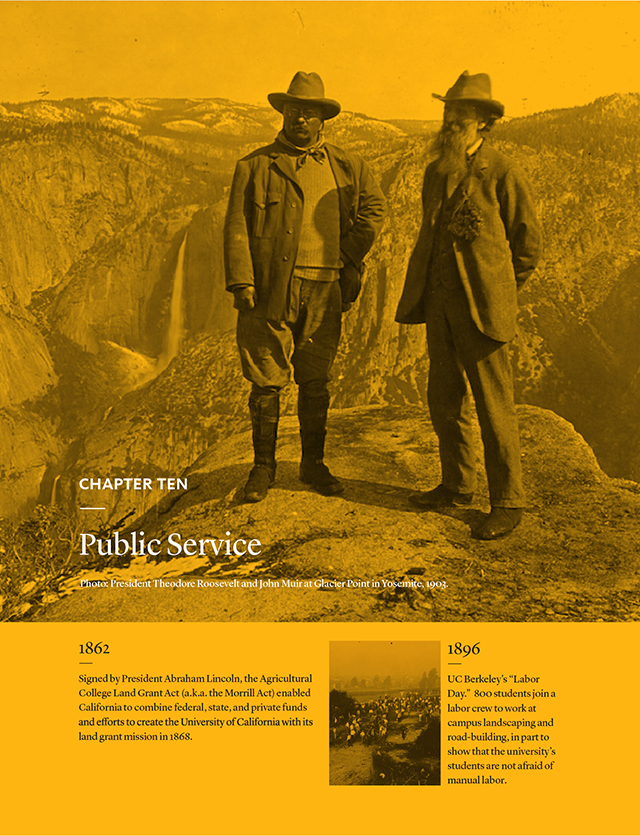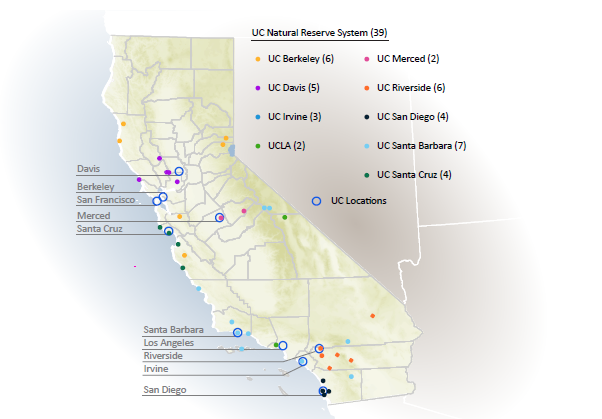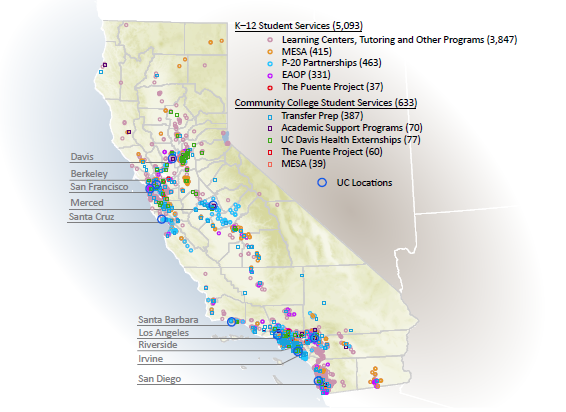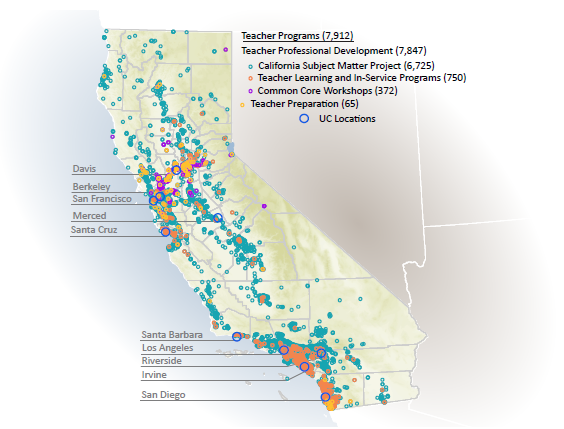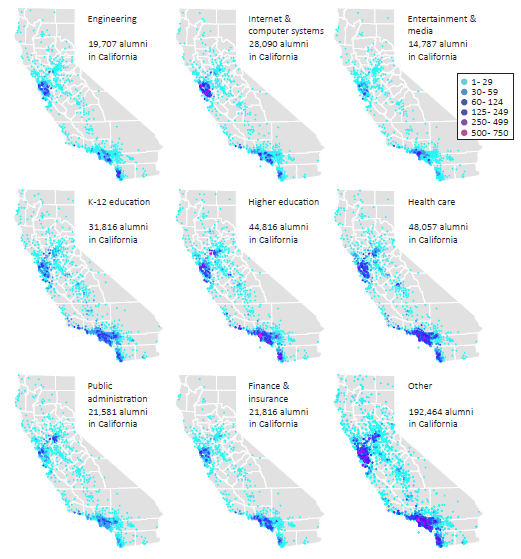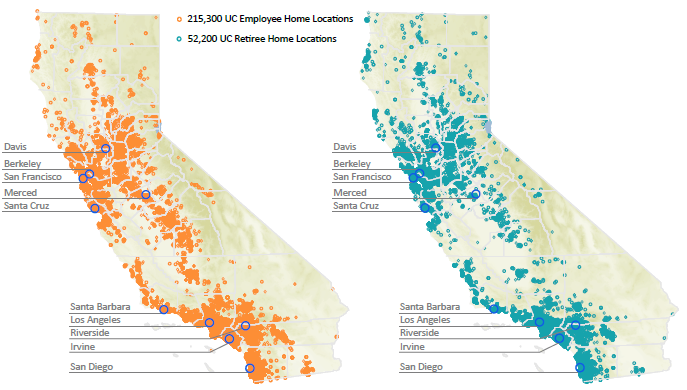History
UC contributes to the well-being of the state’s population and economic growth through its public service mission—a fundamental feature of UC through its history. UC’s impact goes well beyond its on-campus activities, and through a wide range of programs and services UC has a significant presence in nearly every community throughout California.
With the creation of Cooperative Extension (CE) in 1914, the University began community-based education, helping farmers grow more nutritious food. In the 1920s, 4-H clubs coalesced out of UC’s agricultural clubs. UC campuses have long served underprivileged youth throughout the state by founding summer camps, like UniCamp from UCLA in the 1930s, and Cal Aggie Camp from UC Davis in 1961.
UC’s Agricultural Extension Service provided emergency assistance when the St. Francis Dam break flooded parts of Ventura and Los Angeles counties in 1929 and again when drought struck Southern California in 1934, assisting ranchers by purchasing livestock on behalf of the government.
Educational outreach forms a crucial part of UC’s service to the state. In the 1970s, Lawrence Livermore Elementary School Science Study of Nature (LESSON) began in response to a request by an Oakland elementary school teacher for help in teaching science. UCSF has expanded its educational outreach by establishing the UCSF Fresno Medical Education Program, providing an opportunity for students and residents to train in the Central Valley and support local health care needs. UC manages an extensive network of world-class museums, libraries, herbaria and other facilities that are open to the public. The University hosts a range of performances and events that attract audiences from all parts of the state.
The University has a steadfast commitment to public service and exhibits it, in part, through support of sustainable agriculture, environmental stewardship, healthy families and education at all levels. The Division of Agriculture and Natural Resources (ANR), the UC Natural Reserve System, and the community-based programs of the Division of Diversity and Engagement and all ten campuses are highlighted in this chapter.
UC Agriculture and Natural Resources
The Morrill Land-Grant Acts emphasized that the role of the University is to develop “useful and practical information … and to promote scientific investigations and experiments” to address the needs of society through objective research and education.
The Morrill Acts created a federal-state partnership for agricultural research and technology transfer. The partners are the U.S. Department of Agriculture (USDA) and every state and territory’s land-grant college. The University of California was chartered as California’s land-grant university. Subsequently, the Hatch Act of 1887 established state agricultural experiment stations, providing annual federal funding to the state land-grant institutions for agricultural research. In 1914, Congress passed the Smith-Lever Act, establishing Cooperative Extension services to extend university research through outreach and education and providing annual federal funding to the state land-grant institutions. UC’s Division of Agriculture and Natural Resources is UC’s land grant arm. State legislation enabled county governments to become the third legal partner, such that today UC ANR represents a three-way partnership with federal, state and county governments.
UC ANR personnel and programs connect and deliver resources from the UC system to Californians–even if there is no campus nearby. UC ANR forms integrated teams, across UC and beyond, to develop innovative, multidisciplinary, science-based solutions to complex issues. CE is also the education and outreach arm, serving the public in all 58 California counties by bringing UC research to local communities. UC ANR’s mission is to engage UC with the people of California to achieve innovation in research and education that supports:
• sustainable, safe, and nutritious food production and delivery
• economic success in a global economy
• a sustainable, healthy and productive environment
• science literacy and youth development programs
UC ANR operates a statewide network of researchers and educators dedicated to the development and application of knowledge to address local agricultural, environmental, and health issues. This network of local Cooperative Extension sites and Research and Extension Centers (RECs) is often the face of the University to Californians with no other connection to the University. As of January 2018, 170 Cooperative Extension Advisors were conducting research, outreach and education from locally-based CE offices. Nine statewide RECs provide educational opportunities for the public and places for researchers to conduct field experiments. Approximately 580 affiliated Agricultural Experiment Station researchers are located at three campuses and about 115 CE Specialists are located at five campuses, RECs and county offices. UC ANR maintains and enhances connections that engage UC with the people of California through 3,079 local partnership programs (10.1.1).
In 2017, AES and CE combined published over 1,700 publications, 260 popular articles and 125 manuals/other print materials, and developed 22 patents. Locally based CE programs, including volunteers, had over one million educational exchanges with adults and youth across the state. CE academics and volunteers disseminated science-based information through over 250,000 community-based classes, and over 2,000 workshops, demonstrations and field days offered across the state.
UC ANR’s statewide California Naturalist Program uses a hands-on science curriculum and citizen science to foster a diverse cadre of volunteers, working with 40 organizations. The program has over 65 active instructors who taught the California Naturalist course more than 130 times in eight of the state’s ten bioregions. At the end of 2017, over 2,300 participants were trained and recorded over 99,000 hours of volunteer environmental stewardship service, with an estimated value of $2.7 million for the state.
UC ANR’s statewide UC Master Gardener Program extends research-based information about home horticulture, pest management, and sustainable landscape practices to the public. There are approximately 6,000 UC Master Gardener volunteers in 50 California counties. In 2017, they donated close to 400,000 public service hours. Since the program’s inception in 1981, Master Gardener volunteers have donated more than five million hours, with an estimated value of more than $137 million.
UC ANR’s statewide 4-H Youth Development Program is part of the national land-grant 4-H program, which uses a positive youth development framework and experiential, inquiry-based science learning. Approximately 100,000 youth participated in the UC 4-H program during 2017. Youth who participate in 4-H programs have been shown to be 25 percent more likely to see themselves going to college, and more likely to contribute to their communities. In 2015 the UC 4-H program launched the Latino Initiative, adapting programming to better reach and serve California’s growing demographic of Latino children. Latino youth participants reported increases in confidence in their science and engineering abilities and increased knowledge of and skills to engage with the government system. In addition, the UC program has become an International Advisor for 4-H in Mexico.
UC ANR manages two statewide nutrition education programs: the California Expanded Food and Nutrition Program (EFNEP) in 24 counties and the UC CalFresh Program in 31 counties. EFNEP delivers research-based nutrition education to limited-resource families with young children to improve healthy lifestyle choices. In 2017, EFNEP reached over 7,800 adults and 36,000 youth. Evaluations of adult participants indicate 91 percent improved at least one nutrition practice, and 87 percent improved one or more skills for managing their food budget. The UC CalFresh Program is a joint agreement involving the USDA, California Department of Social Services and UC Cooperative Extension. The program serves persons eligible for the federal Supplemental Nutrition Assistance Program (SNAP-Ed) and in 2017, in-person education was provided to 162,220 participants. Evaluation findings showed gains in healthy eating behaviors and organizations reported policy, system or environmental improvements, e.g. in school lunchrooms, farm-to-school programs and school gardens.
UC ANR strives to have a positive impact on the life of each of Californian’s 40 million residents, and contributes to environmental, health and economic condition changes throughout the state.
California is a national and global leader in food production and agricultural exports, all of which are affected by social, regulatory, economic and environmental challenges. UC ANR lives and works in communities, communicating research findings through demonstrations and educational programs to improve food quality, quantity, safety and access. UC ANR creates practical solutions and informs policy and as a result, Californians have increased access to abundant, affordable, safe and healthy food thanks to UC ANR research, outreach and education, growers are changing their practices, resulting in increased yield and efficiency as well as reduced inputs, and individuals and households are improving financial management practices.
Research shows that proper management of our natural resources is necessary for safe and healthy environments. UC ANR translates research into actionable management strategies to protect the environment and increase the long-term viability of farming, ranching and forestry in California. Through outreach and education, UC ANR recommends practices for grazing and rangeland management, water conservation and preserving water quality, and sustainable use of forest and wildland resources. Increased ecological sustainability of agriculture, landscapes and forestry helps California realize the many benefits of the state’s rich and diverse natural resources.
California’s rapid population growth increases pressure on community resources, presenting challenges to health and safety. UC ANR produces tools, programs and policy-relevant research that result in healthy living for individuals and communities. Program participants adopt healthier lifestyles and communities gain improved access to green spaces and healthy foods. Benefits also include safe drinking water, clean air and reduced exposure to pesticides. Collectively, these efforts contribute to a healthier California, improving public health and reducing healthcare costs.
UC’s environmental stewardship portfolio includes projects beyond the scope of ANR. The University of California directly manages lands for research, teaching and public service. The UC Natural Reserve System (NRS) is a network of protected natural areas throughout California. Its 39 reserves, covering more than 756,000 acres, make it the largest university-administered reserve system in the world (10.2.1). These lands provide undisturbed environments to conduct research, enhance students’ educational experiences and provide sites for public service programs. The latest addition is the Merced Vernal Pools and Grasslands reserve, next to UC Merced.
Most major state ecosystems are represented within the NRS, from coastal tidepools to inland deserts, oak savannas to offshore islands, and wetlands to Sierra Nevada forests. Reserves also serve as gateways to more than a million acres of public lands. NRS reserves include lands purchased by the University, donated by private landowners, and made available to the reserve system via partnerships with state and national parks, land trusts and government agencies. Reserve amenities such as classrooms, lodging, laboratories and internet access attract tens of thousands of users each year. These include researchers, students in university courses, schoolchildren and the general public.
Those who seek to understand the workings of natural California come to the NRS to take classes, develop field skills and conduct research. More than 150 undergraduate courses across the UC system include visits to NRS reserves each year. Topics of study range from botany to zoology, archaeology to environmental planning, public health to the performing and visual arts. Among these is the NRS’s California Ecology and Conservation course, which brings undergraduates from each of UC’s general campuses to reserves for seven weeks.
Scientists flock to reserves because reserve lands are protected in perpetuity. They feel comfortable launching long-term studies within reserve boundaries. Work at reserves produced more than 862 peer-reviewed papers, book chapters and books between 2011 and 2014.
As one of four trustee agencies recognized under the California Environmental Quality Act, the University of California holds reserve natural resources in trust for the people of the State of California. The NRS serves the public good by protecting these natural resources and preserving biodiversity. The care of reserve lands and resources is central to the mission of the NRS. Reserve managers protect endangered plants and animals, restore native habitats and control invasive species to ensure the health of these ecological oases.
Reserves also serve the public by holding lecture series, guided hikes and other community events; lending scientific expertise to conservation initiatives, and hosting tens of thousands of California schoolchildren on field trips.
More than fifty years after its inception, the need for the NRS has never been greater. Climate change, pollution, extinctions and invasive species are fraying the fabric upon which life on Earth depends. By supporting university-level teaching, research and public service, the NRS contributes to the understanding and wise stewardship of the Earth.
Educational partnerships
For more than 40 years, the University of California’s Student Academic Preparation and Educational Partnerships (SAPEP) programs have helped prepare California students for higher education (10.3.1). Program activities are centered on student academic preparation, community college articulation support, school and community partnerships, and online and technology-assisted services. Collectively, SAPEP programs served nearly 160,000 K-12 students at more than 1,100 public schools in 2015–16.
The goal of these programs is to promote student achievement by supporting academic preparation and college readiness. Programs include the Early Academic Outreach Program (EAOP), which focuses on “a–g” course completion (a pre-requisite for admission to UC and CSU); K-20 Regional Intersegmental Alliances (aka P-20), creating ties between campuses, schools, local communities and business organizations; The Puente Project, focusing on college-preparatory English skill development; Transfer Prep, focusing on community college transfer support; and Mathematics, Engineering, Science Achievement (MESA), focusing on STEM (science, technology, engineering and mathematics) skills development.
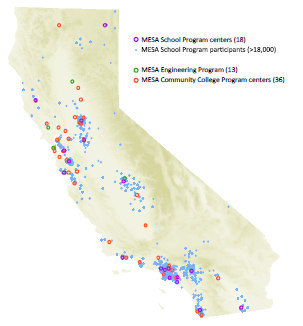
The Mathematics, Engineering, Science Achievement (MESA) program integrates UC’s core missions of teaching and public service by focusing on the academic preparation of students at K-12 schools, community colleges and four-year universities. Through its three components — the MESA Schools Program (MSP), the MESA Community College Program (MCCP) and the MESA Engineering Program (MEP) — MESA serves more than 25,000 California students annually.
MESA Schools Program (MSP) centers are housed in 18 locations and serve more than 18,000 students at about 400 K-12 schools. Centers offer classes before, during and after school on activities that reinforce math and science content standards. MESA activities include workshops aimed at strengthening students’ study skills and monitoring students’ progress.
The MESA Community College Program (MCCP) manages 36 centers at community colleges, serving around 4,000 students annually. These centers provide academic excellence workshops, orientation courses, academic advising and counseling activities dedicated to helping community college students develop multi-year plans to transfer to a four-year university in a timely manner.
The MESA Engineering Program (MEP) operates 13 centers located in public (UC and CSU) and private universities across the state. Serving about 3,000 students annually, these centers assist college students in attaining four-year degrees in engineering and computer science by providing tutoring and academic skills workshops. In partnership with local industry leaders, MEP centers also provide career and professional development opportunities for students.
In addition to the activities UC undertakes to strengthen K-12 and community college students academically, UC plays an important role in preparing California’s teacher workforce. UC’s Teacher Education Programs prepare teacher candidates to engage students in rigorous, relevant and inquiry-based educational experience. Located at eight UC campuses, Teacher Education Programs recruit, prepare and support educators who are committed to academic excellence, equity and integrity, and to cultivating the highest levels of achievement and opportunity for all students.
UC also provides ongoing support to educators already in the workforce through professional development programs. For example, the California Subject Matter Project (CSMP) is a network of nine discipline-based statewide projects, providing more than 2,000 professional development programs for educators at more than 10,000 schools each year. CSMP professional learning opportunities are aligned with state-adopted standards and are collaboratively designed by K-12 and university educators to enhance learning for all students (10.3.2).
Social and economic impact
Including the programs of ANR, the Natural Reserve System and UC’s educational partnerships mentioned above, the University of California administers more than 20,000 community-based programs across the state. Because the well-being of every California citizen and community is important, all campuses sponsor and manage programs far from their locations. For example, UC San Diego, near the southern border of California, runs clinical internship sites in Crescent City and other communities near the northern border of California; UC Davis, in the Central Valley, runs the Oiled Wildlife Care Network in Morro Beach on the central coast; and UC Santa Barbara, on the California Coast runs the Outdoor Science Education Program in several locations on the east side of the Sierra Nevada range. All of UC’s community-based programs may be discovered and explored here.
Through community and social services programs and cultural resources and arts programs, UC administers internship and field study programs that connect students and alumni with their communities; volunteer centers working on issues such as domestic violence, fair housing advocacy and employment training; arts education and outreach programs that teach art, dance, drama, music and digital arts in the community (10.4.1).
Through business and economic development programs and public policy programs, UC facilitates internships offered in partnership with local companies, where students gain both UC credits and professional experience. Other programs bring local high-tech and green-tech companies together with motivated individuals to foster student participation in community economic development (10.4.1).
As California’s economy becomes increasingly dependent on highly educated workers, the role of the University of California in training the state’s future workforce becomes more vital. Industries relying on skilled workers in the STEM fields represent a major component of California’s economy. UC awards half of the state’s bachelor’s degrees in STEM fields.
More than 1.2 million UC alumni live and work in California (10.4.2). They are leaders, volunteers and contributors to the vitality of its communities, businesses and culture. UC’s operations also add significantly to the state’s economy. With approximately 210,000 employees, UC is one of California’s largest employers (10.4.3). With expenditures of about $29.5 billion, much in the form of salaries, wages and benefits, UC annually generates more than $46 billion in economic activity in California. UC contributes more than $32 billion to the gross state product and attracts over $8 billion in annual funding from outside the state.
True to its land-grant mission, the UC system touches many aspects of life in California. The UC public service mission has evolved in tandem with the changing needs of our state and local communities, and has developed programs and partnerships that improve the lives of all Californians.
For more informatioN
